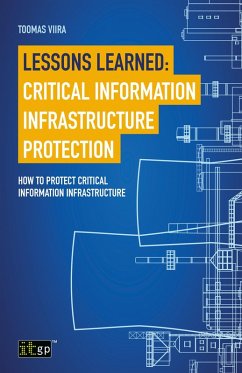"e;I loved the quotes at the beginning of each chapter - very interesting and thought-provoking. I also enjoyed the author's style and his technical expertise shone through."e;Christopher Wright, Wright CandA Consulting LtdUnderstand how to protect your critical information infrastructure (CII).This book comes with 23 key lessons, including how to:Describe the critical infrastructure service and determine its service level;Identify and analyse the interconnections and dependencies of information systems;Create a functioning organisation to protect CII; andTrain people to make sure they are aware of cyber threats and know the correct behaviour.Billions of people use the services of critical infrastructure providers, such as ambulances, hospitals, and electricity and transport networks. This number is increasing rapidly, yet there appears to be little protection for many of these services.IT solutions have allowed organisations to increase their efficiency in order to be competitive. However, do we even know or realise what happens when IT solutions are not working - when they simply don't function at all or not in the way we expect? This book aims to teach the IT framework from within, allowing you to reduce dependence on IT systems and put in place the necessary processes and procedures to help protect your CII.Lessons Learned: Critical Information Infrastructure Protectionis aimed at people who organise the protection of critical infrastructure, such as chief executive officers, business managers, risk managers, IT managers, information security managers, business continuity managers and civil servants. Most of the principles and recommendations described are also valid in organisations that are not critical infrastructure service providers. The book covers the following:Lesson 1: Define critical infrastructure services.Lesson 2: Describe the critical infrastructure service and determine its service level.Lesson 3: Define the providers of critical infrastructure services.Lesson 4: Identify the critical activities, resources and responsible persons needed to provide the critical infrastructure service.Lesson 5: Analyse and identify the interdependencies of services and their reliance upon power supplies.Lesson 6: Visualise critical infrastructure data.Lesson 7: Identify important information systems and assess their importance.Lesson 8: Identify and analyse the interconnections and dependencies of information systems.Lesson 9: Focus on more critical services and prioritise your activities.Lesson 10: Identify threats and vulnerabilities.Lesson 11: Assess the impact of service disruptions.Lesson 12: Assess the risks associated with the service and information system.Lesson 13: Implement the necessary security measures.Lesson 14: Create a functioning organisation to protect CII.Lesson 15: Follow regulations to improve the cyber resilience of critical infrastructure services.Lesson 16: Assess the security level of your information systems yourself and ask external experts to assess them as well.Lesson 17: Scan networks yourself and ask external experts to scan them as well to find the systems that shouldn't be connected to the Internet but still are.Lesson 18: Prepare business continuity and disaster recovery plans and test them at reasonable intervals.Lesson 19: Establish reliable relations and maintain them.Lesson 20: Share information and be a part of networks where information is shared.Lesson 21: Train people to make sure they are aware of cyber threats and know the correct behaviour.Lesson 22: If the CII protection system does not work as planned or give the desired output, make improvements.Lesson 23: Be prepared to provide critical infrastructure services without IT systems. If possible, reduce dependence on IT systems. If possible, during a crisis, provide critical services at reduced functionality and/or in reduced volumes.AuthorToomas Viira is a highly motivated, experienced and results-orientated cyber security risk manager and IT auditor. He has more than 20 years' experience in the IT and cyber security sectors.In 2005, Toomas managed the creation of CERT (Computer Emergency Response Team) Estonia, and in 2007 he was a member of the team that protected Estonia from large-scale cyber attacks. He is one of the main authors of the first Estonian Cyber Security Strategy and in 2009 was appointed head of the Critical Information Infrastructure Protection department at the Estonian Information System Authority.Toomas has managed several national-level CII projects, such as mapping, risk analysis and operators' penetration tests, and state-level emergency risk analysis and response plan development. He holds the following certifications: CISSP CISA CISM CRISC ISO 27001 CIS LI and ITIL Foundation. Toomas is the fou
Dieser Download kann aus rechtlichen Gründen nur mit Rechnungsadresse in A, B, BG, CY, CZ, D, DK, EW, E, FIN, F, GR, HR, H, IRL, I, LT, L, LR, M, NL, PL, P, R, S, SLO, SK ausgeliefert werden.









